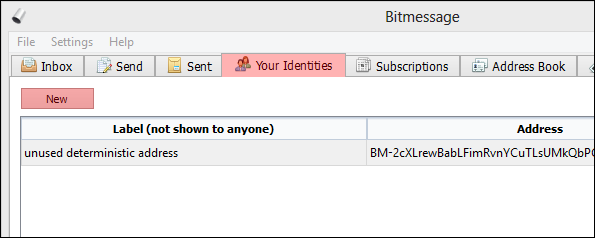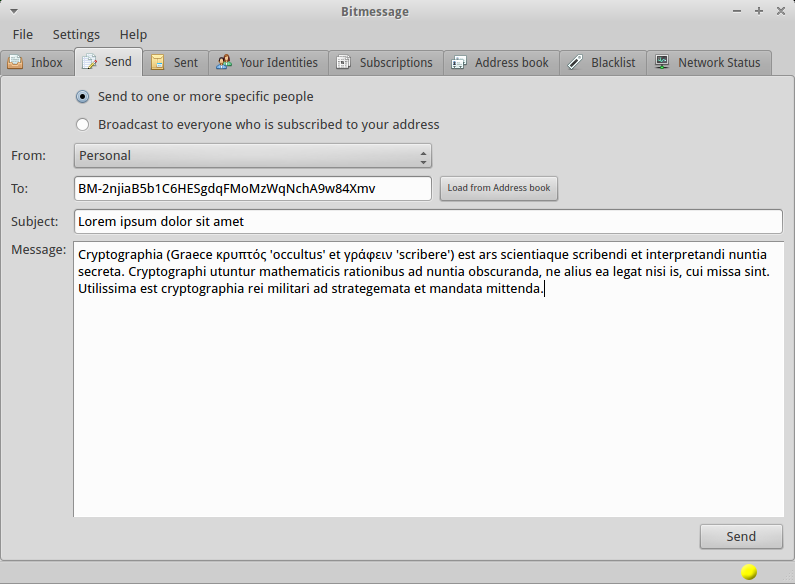

- BITMESSAGE MAC SOFTWARE
- BITMESSAGE MAC MAC
The main aim of the software was to increase a user’s privacy beyond what is offered by email and PGP, but also to be easier to use. This scheme provides a strong theoretical basis for providing anonymous communication as will be explored in this chapter. (Note: this text was first written in 2015 and has not been updated to reflect any possible changes in BitMessage) 4.1 – Introduction and overview Weaknesses will also be addressed before a conclusion is drawn. This chapter will review the following aspects of BitMessage: In this chapter BitMessage will be discussed in enough detail such that its methods for providing anonymous communication can be understood, both theoretically and in practise. It has been picked as potentially the strongest candidate for ensuring anonymity in communication, and in theory could achieve all five levels of anonymity (as outlined in section 2.1.4) and that it uses many of the ideas identified in section 3.2 to ensure anonymity of communicants and robustness of the network. As a result, even when considering parallelization, the performance differences are tiny, and they're inverted between encryption and decryption, so once again the generic construction matters less for performance than the details of the algorithms.One of the most promising schemes for facilitating anonymous communication is BitMessage. Furthermore, the parallelization penalty is inverted for decryption.

Thus the parallelization penalty is only one block regardless of the message length.
BITMESSAGE MAC MAC
MAC the second block while encrypting the third block.Īnd so on. MAC the first block while encrypting the second block. However, most primitives process the data one small block at a time from left to right, so as soon as encryption has processed one block, you can start the MAC operation with that block: thus encrypt-then-MAC can be parallelized as On the contrary, MAC-and-encrypt allows the encryption and the MAC to be parallelized apart from the last step of encrypting the MAC. Taking for example encrypt-then-MAC, the input to the MAC is the output of encryption, so you can't do the two perfectly in parallel. It is attractive to do the authentication calculation and the encryption/decryption calculation in parallel if your hardware supports it. So there is no meaningful difference between the generic approaches.Ībove I didn't take parallelization into account. This is a constant cost (independent of the message length) and it's the same order of magnitude as other details of the algorithms, such as whether padding is involved, how the length of the message is encoded, how the key is prepared for use, etc. The difference is, at most, whether you need to encrypt/decrypt the MAC value. In all cases, for a message of length n, you need to calculate the MAC of n bytes and the encryption or decryption of n bytes. In the other direction, given C || T, decrypt C to find P and check that T is the MAC of P. MAC-and-encrypt: encrypt the plaintext C = E(P) and append the MAC of the plaintext T = M(P). In the other direction, decrypt the ciphertext, split the result as P || T and check that T = M(P). MAC-then-encrypt: calculate the MAC of the plaintext T = M(P) and encrypt the plaintext with the MAC appended E(P || T). In the other direction, given C || T, check that T is the MAC of C then decrypt C to find P. Encrypt-then-MAC: encrypt the plaintext C = E(P) and append the MAC of the ciphertext T = M(E(P)). Setting aside hash-then-encrypt which mostly doesn't work, there are three methods. There's interesting stuff to say about their relative security but not a lot to say beyond “basically the same”. You aren't finding much about performance because it's basically the same.






 0 kommentar(er)
0 kommentar(er)
